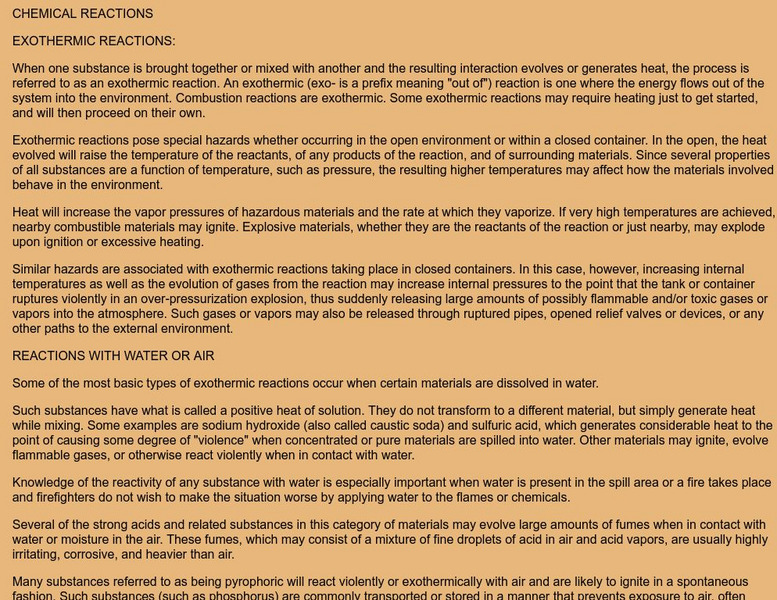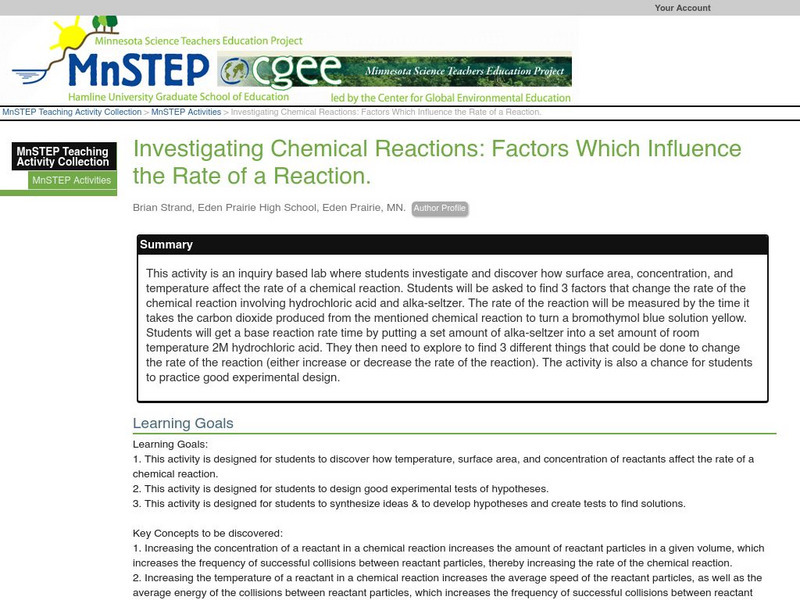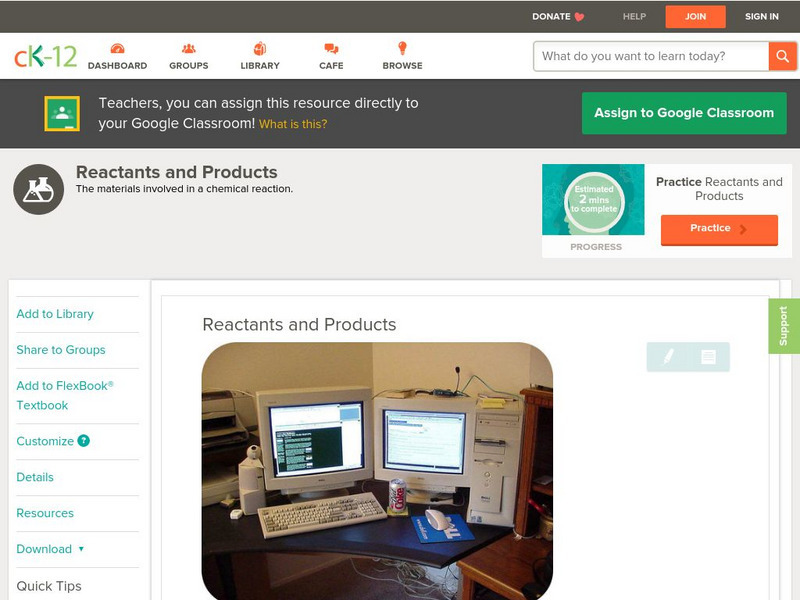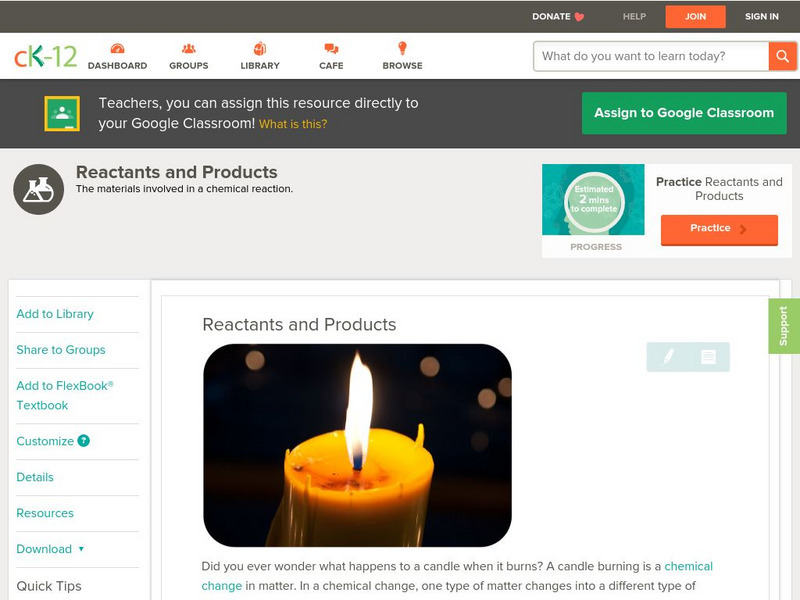Curated OER
Chemical Equilibrium Homework Problem Set
In this chemistry worksheet, students write an equilibrium expression for each of the chemical reactions listed. Then they use the equilibrium constant to calculate the equilibrium pressure of each species under the given conditions.
Other
Chemical Reax/exothermic Reactions
A wonderfully complete primer on exothermic reactions in the context of chemical spills. Covers Reactions with Air or Water, Combustible Organics, Polymerization Reax, Decomposition, Corrosion, and much much more.
American Chemical Society
Middle School Chemistry: Lesson Plans: What Is a Chemical Reaction?
After observing a demonstration of a chemical reaction between a burning candle and the oxygen in the air, learners use atom model cut-outs to model the reaction and see that all the atoms in the reactants show up in the products.
OpenStax
Open Stax: Chemical Reactions
This site provides an overview of the role of energy in chemical reactions.
American Chemical Society
Middle School Chemistry: Controlling Amount of Products in a Chemical Reaction
Students analyze the chemical equation for the reaction between vinegar and baking soda. They observe that the gas produced in the reaction is also part of the products of the written chemical equation.
Science Education Resource Center at Carleton College
Serc: How Big Is the Balloon?
A chemistry lab where young scholars investigate limiting reagents and balanced chemical equations. A simple experiment that gives students a physical example of what limiting reactant means.
Science Education Resource Center at Carleton College
Serc: Investigating Chemical Reactions: Factors Which Influence Rate of Reaction
In this activity, students investigate and discover how surface area, concentration, and temperature affect the rate of a chemical reaction. This lab is designed for students to practice good experimental tests of hypotheses, synthesize...
Center of Science and Industry
Cosi Columbus: Sidewalk Chalk
Make your own sidewalk chalk, and learn about chemical reactions. During the procedure, feel the heat as energy is released in an exothermic reaction.
CK-12 Foundation
Ck 12: Chemistry: Reactants and Products
[Free Registration/Login may be required to access all resource tools.] Defines reactant, product, and chemical equation.
CK-12 Foundation
Ck 12: Physical Science: Reactants and Products
[Free Registration/Login may be required to access all resource tools.] Reactants and products in chemical reactions and the relationship between reactants and products.
CK-12 Foundation
Ck 12: Chemistry: Conservation of Mass
[Free Registration/Login may be required to access all resource tools.] Describes the law of conservation of mass.
CK-12 Foundation
Ck 12: Physical Science: Chemical Reaction Overview
[Free Registration/Login may be required to access all resource tools.] Provides an introduction to chemical reactions.
Sophia Learning
Sophia: Chemical Reaction Types: Synthesis
A video lesson which illustrates how to identify and complete a synthesis chemical reaction. [8:08]
Sophia Learning
Sophia: Chemical Reaction Types: Synthesis
A narrated tutorial which describes how to identify and complete a synthesis reaction. [9:55]
Sophia Learning
Sophia: Changes in Concentration at Equilibrium
This lesson will provide examples of how to identify an equilibrium shift due to a change in concentration of either reactants or products.
Sophia Learning
Sophia: Chemical Reactions: Stoichiometry
This lesson on stoichiometry demonstrates how to use a balanced chemical equation to determine the mass of a product given the starting mass of a reactant. [7:55]
Khan Academy
Khan Academy: Limiting Reagents and Percent Yield
How to determine the limiting reagent, and using stoichiometry to calculate the theoretical and percent yield.
Other
Nearpod: Photosynthesis
In this activity on exploring photosynthesis, students will explore photosynthesis by examining the reactants and products of this process.
Sophia Learning
Sophia: Limiting Reactant Definition: Lesson 2
This lesson will define a limiting reactant and its significance as well as the term "in excess". It is 2 of 2 in the series titled "Limiting Reactant Definition."
Sophia Learning
Sophia: Limiting Reactant Definition: Lesson 1
This lesson will define a limiting reactant and its significance as well as the term "in excess". It is 1 of 2 in the series titled "Limiting Reactant Definition."
Sophia Learning
Sophia: Limiting Reactant Percent Yield: Lesson 1
This lesson will demonstrate how to determine the percent yield of a substance using the theoretical yield of the reaction. It is 1 of 2 in the series titled "Limiting Reactant - Percent Yield."
Sophia Learning
Sophia: Chemical Reactions: Lesson 5
This lesson introduces the process of writing the equation for chemical reactions. It is 5 of 9 in the series titled "Chemical Reactions."
Sophia Learning
Sophia: Chemical Reactions: Lesson 7
This lesson introduces the process of writing the equation for chemical reactions. It is 7 of 9 in the series titled "Chemical Reactions."
Sophia Learning
Sophia: Chemical Reactions: Lesson 8
This lesson introduces the process of writing the equation for chemical reactions. It is 8 of 9 in the series titled "Chemical Reactions."






















